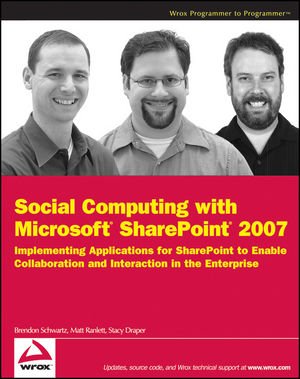Social Computing with Microsoft SharePoint 2007: Implementing Applications for SharePoint to Enable Collaboration and Interaction in the EnterpriseISBN: 978-0-470-42138-3
Paperback
408 pages
February 2009
 This title is out-of-print and not currently available for purchase from this site.
|
1. Intro.
Web 2.0 (loosely) defined.
Overview.
Business Value and relevance to the enterprise.
Enterprise 2.0.
Open Source.
2. Taxonomy, site structure, governance (Building Effective Collaboration Sites).
3. Content Tagging.
Why Tag Content?
Surface data using tagged content.
How tagging connects items in a site.
4. Wikis.
How Wikis Work.
Online uses of Wikis (MediaWikis).
Functionality of Wikis.
Common usage scenarios.
Explain Wiki History and Versioning.
Tokens.
Extensions with open source and third party tools (cks) stuff.
History.
Components.
Pages.
Open source implementations.
Example sites.
5. Blogs.
History.
Reasons for Blogging.
SharePoint Blogs.
Possibilities with Blogs (CKS).
Adding blog components.
Using category tagging.
6. RSS and ATOM.
What are RSS Feeds.
History of RSS.
Search Results RSS.
Lists with RSS.
Applications to view RSS.
Email vs RSS.
7. Social Networking.
Online community leads the enterprise.
Add integration with extended application (Fuzzy).
SharePoint My Sites.
User Profile Information.
Value of SC applications.
Example Sites.
8. Podcasting.
Determine your audience.
How to pin point your target audience.
Creating an archive.
Provide content and information relevant to the listeners.
9. Mashups.
Reasons to assemble data.
Types of data sources.
Visualization on the web.
Example using virtual earth.
Example sites.
10. Presence and OCS/Live.
11. Interactive Media/Video and communication.
Video.
Effective communication with newsletters.
Using Publishing sites for PR Departments.
12. Search.
Surfacing the right data in an organization.
Using Search to surface data.
SharePointPedia.
Filtered Results.
Governance –a subset of every chapter rather than a chapter on its own.



